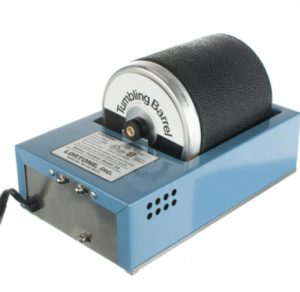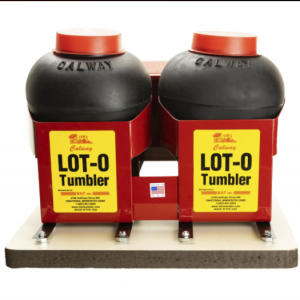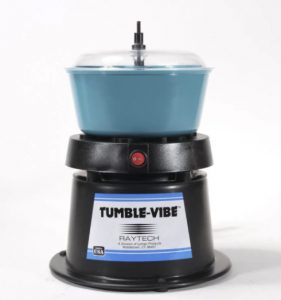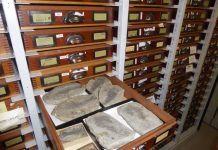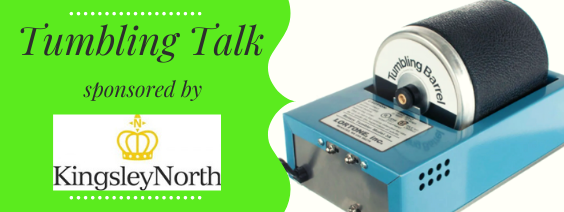
By Jim Brace-Thompson
Tumble-polished stones are an honored, time-tested stock-in-trade at the kids’ booths of local gem club shows all around the world. Kids love them! In fact, I still have the small tumble-polished Oregon beach agate I received at the very first gem show I ever attended as a little kid nearly 60 years ago. For many years, I carried the shiny orange treasure in my pocket. Every gem and mineral society ought to have at least one member (preferably more) designated to craft and provide a supply of such translucent little gems. Then, as that supply builds up, get creative in what to do with the inventory!
If you are in a large active society, tumbling rough is fairly easy to come by. For instance, in my own Ventura Gem & Mineral Society (VGMS), our workshop stewards, lapidary artists, and one local dealer are always happy to pass along discarded bits from their slabbing, cabbing, and sphere making efforts. We also have a considerable club rock pile to source, where I pick out chunks of jasper and agate that show good color and/or promising hints of interesting pattern. These get broken into tumbling sized bits on a block of concrete on my backyard patio with a heavy crack hammer.
A word of advice: Wear thick leather gloves and eye protection to guard against sharp shards that can fly like shrapnel!
Ever Watchful for Stones
Finally, during club field trips or walks along the beach, I’m always on the lookout for little stones with tumbling potential and try to come home with at least a small batch to add to my stockpile. With that stockpile now approaching something like a half dozen five-gallon buckets on that backyard patio, I’m never at a loss for tumbling rough. In fact, with so much on hand, I’ll often fill a couple of gallon size Ziploc bags with rough stones to sell as “Bag o’ Rocks” at our various club silent auctions to raise money for the society while encouraging others to join in the tumbling fun.
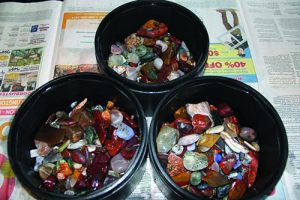
While I’ve found tumbling rough to be relatively easy to come by, tumbling those rough stones requires a long-term committed investment in money and time.
First, the time aspect. Getting a mirror-like polish out of a dull rough stone does not happen overnight. If you follow the standard procedure with a rotary tumbler, it can take a month to produce finished results. The length of time is because you’ll patiently grind your way through the necessary rough, medium, fine, and polish stages (although with a well-rounded beach agate, you may be able to skip the rough grind). At any one time, I always have at least three rotary tumblers spinning in my garage. While vibratory tumblers can speed the process (and I’ve recently purchased one for experimenting), even then, there’s still a considerable investment of time.
Next is the investment of money. Sure, you can get a small basic tumbler for as little as $50, but as we all know, you get what you pay for. Keep in mind that these machines will be running 24 hours a day seven days a week for a month at a time just to finish a single load. Virtually everyone who has purchased an inexpensive (i.e., “cheap”) machine has complained to me that it has broken down with a burnt-out motor or a snapped belt after just a single load or two. Commercial grade machines can be had for as much as $700 to $800 or more.
I, myself, prefer the Goldilocks price range, that is, neither too low nor too high, but just right!
Trusting the Tried and True Equipment
After a couple tries with other models, I have always gone for the Lortone QT6 model, which currently retails for around $200. There are other equally good manufacturers and models out there, but this one has proven to be a truly reliable workhorse for me for going on twenty-five years now.
Editor’s Note: You can find various Lortone and other brands of tumblers (including those shown below) at the Kingsley North website >>>
Beyond the initial investment in a machine, you then have to feed the machine with a steady diet of grit in three grades—rough, medium, and fine—followed by a dose of expensive polish. And don’t stop to think about what running a tumbling device nonstop does to your electric bill! My wife has also gently suggested we might want to consider moving the noisy tumblers out of the garage and to a place that’s not right next to the bedroom, but I find the white noise of a tumbler tumbling in the dark of night strangely soothing to the soul.
Over the years, I have learned to maximize the results from this investment of time and money. Purists within the tumbling community will often work with batches of a single type of stone (preferably from the same locality, even), but I’m not that pure. Instead, I’ll usually work with mixed batches of jaspers, agates, and other stones so long as they all share the same relative hardness on the Mohs scale. (Most of the stones I work with for tumbling fall within the range of Mohs 6 to Mohs 7.) At the end of the process, I then have a nice variety of stones to use for different purposes.
Once that month-long grinding and polishing process is over, I start dividing finished stones into four piles graded by size and quality, but mostly by size. If you are truly earnest, you might even construct sifting screens with two or three different sizes of wire mesh to speed the grading process. But I’m not that anal. Yet.
Assessing Stone Materials
Pile One holds larger, better quality stones. These include banded agate, agates with inclusions, picture jasper, tiger eye, and any stones with exciting, eye-catching patterns
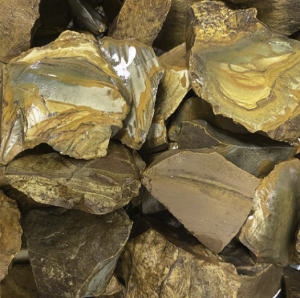
as seen, for example, in poppy jasper. Other stones placed in Pile One include those with vibrant colors, such as purple amethyst, green aventurine, hot-pink rhodonite and rose quartz, yellow and orange Oregon beach agates, blue lapis or sodalite, etc.
All of the Pile One specimens get “First Class” treatment. I gussy them up by putting them into 2X2- or 2X3-inch baggies along with a label printed on cardstock to identify what they are and, if known, their locality of origin. I’m a big believer that we should do everything possible to instill in kids the importance of provenance in the gem and mineral collecting hobby.
We also use these nicer, packaged stones as spinning wheel prizes at our annual VGMS gem show, where kids pay just a buck a spin for a rocky reward. These packages are a real bargain in that I’ve seen similar stones sold in rock shops and museum gift shops for anywhere from three to ten dollars. We have also used these stones in other ways. For instance, as gifts for teachers or as freebies for kids who complete a “Scavenger Hunt” questionnaire evaluating different aspects of our gem show.
If you have talented wire wrappers in your society, you might enlist them to use some of these primo stones for crafting wire-wrapped pendant necklaces to sell in your kids’ booth. Or perhaps they might use a little supply to host lessons for kids on wire wrapping and on making quick-and-easy pendants with glue-on bell caps. This activity could take place right in the show kids’ booth, or you might make it an event to do with the kids in your society on a workshop day if you run an active Pebble Pups and Juniors program. Tumbling Tip: A good time of year to hold such a workshop is around Father’s Day, Mother’s Day, and ahead of the holiday season.
Making the Most of Everything
Pile Two holds larger stones that are still shiny and pretty but more on the duller side of the color spectrum. For instance, instead of a vivid red, you may have rust-red jaspers. Instead of a hot-pink rhodonite, you may have a pale pink chalcedony agate. Pile Two also holds clear or milky-white agates or brown and yellow jaspers.
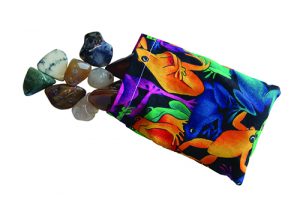
Usually, the stones in this pile have little or no appealing pattern. Such stones get “Economy Class” treatment. While some of the better ones might end up in 2X2- or 2X3-inch baggies with labels to identify what they are and where they came from, most are destined for use as grab bag filler to augment the higher quality stones and fossils that we typically include in our grab bags.
Pile Three consists of high-quality stones that are pretty and colorful and may have beautiful bands or other nice patterns but are too small to serve as individual prizes or even as grab bag filler. With such smaller stones, there is strength in numbers! These get “Business Class” treatment, so long as they team up.
I take anywhere from three to six individual specimens from this pile and glue them onto small cards that I’ve developed with grids containing identifying info to craft “Gemstone Collections.” These are finished off by inserting the cards into 3X4-inch baggies. These make nice spinning wheel prizes. They can also serve as promotional items for your local society if you print necessary information about the society and prominently display its web address on the back of the card.
Treasure Chest Discoveries
As another use for such smaller but colorful stones, we stock a “Treasure Chest” that we put out front-and-center on the welcome booth near the front door at our show to provide each newly arriving child with a free stone right off the bat. I also line kids up and let them pick through a treasure chest activity when home-schoolers, Scouts, or other groups of kids take a field trip to our club’s little two-room museum. I will typically do the same thing when making visits to school classrooms to give invited presentations on rocks and minerals. Just as a warning: some kids will want to paw over every pebble in the chest and will still be unable to make up their minds about which one to pick, even as classmates clamor behind them to hurry up!
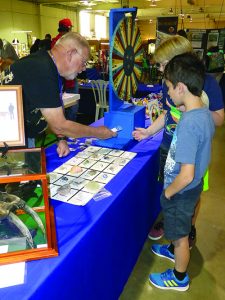
In addition to using tumbled stone as prizes or gifts, the flatter, more translucent rocks of this size may be incorporated into a kids’ booth activity, namely, making suncatchers. As a base, you might use plexiglass disks or the plastic tops of containers such as Pringles chip canisters with a small hole drilled near the edge. Kids glue on stones then run fishing line through the hole for a colorfully sparkling and ready-made object of art to hang against a windowpane.
Finally, Pile Four consists of stones that most folks would not even consider for Economy Class. All-too-often, these are simply tossed out. To use my Grandma’s phrase, these are the tiny “chibblin’s and nibblin’s” that seem far too small to serve any useful purpose. But, to use Yoda’s phrase, “useful are they, yes!”
I insert the tiniest chips into small glass vials that are less than two inches long (the sort of vials that gold panners like to use), thus crafting “Gemstone Jars.” I package these in 2X3-inch baggies along with a little card. Like the Gemstone Collections, the jars have proven to be popular as spinning wheel prizes. I have put larger chibblin’s and nibblin’s into either 2X2-inch baggies or somewhat larger jars like the single-portion jelly jars from hotels and restaurants. Once again, these get used as spinning wheel prizes.
Sand-Sifting Materials Too
We also use such small polished pieces for a sand-sifting activity at the kid’s booth, where kids use a screen or colander to pick a half dozen gems, minerals, fossils, or beads from a plastic tub filled with sand. One fellow VGMS member has suggested such chips might be drilled and used for constructing gemstone wire trees as another activity. But anyone who faints at the sight of blood and who has seen me in action with a tiny stone and a hand-held Dremel or Foredom drill might want to avert their gaze!
Do you have more ways in which you’ve employed tumbled polished stones, either at your annual club show or during workshops with your society’s Pebble Pups? If so, I’d love to hear about your experiences and good suggestions!
As you can see, I have found many ways you can use your tumble-polished stones at your next club gem show, even the tiniest stones you may have previously tossed into the bin as a useless by-product. You put a lot of time, effort, and expense into tumble polishing those stones. Why not maximize the results?
Visit Kingsley North for all of your tumbling and lapidary equipment and supply needs www.kingsleynorth.com.


